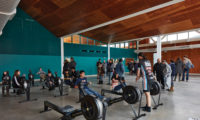Salt River Fields at Talking Stick
















HKS, Inc.
Scottsdale, Arizona
When the Arizona Diamondbacks and the Colorado Rockies decided to move their spring-training operations from Tucson and share a new facility in the Phoenix metropolitan area, the teams wanted more than a state-of-the-art ballpark. For the hundreds of thousands of supporters who come out each spring to watch practice games, picnic on the stadium lawn, and cut loose before the baseball season begins, the Diamondbacks and Rockies (who are otherwise unaffiliated) set out to create the best fan experience in the major leagues.
The teams found a home in the Salt River Pima-Maricopa County Indian Community, which invested in creating just such an off-season venue called Salt River Fields at Talking Stick, designed by HKS. Unlike a traditional stage-managed sports arena, Salt River Fields invites fans to choose how they experience the game. Visitors enter via ramped sidewalks with views that clarify the logic of the site. To encourage them to explore Salt River as they would a regular park, the architects organized the site in an organic circular pattern around the concrete-and-steel-structure stadium. If the fans don't want to sit in the 11,000-seat stadium or on its large lawn, they can walk around to see the activity at the dugouts, batting cages, and practice fields. “Rather than have one or two places to watch, we probably have 25 ways you can see a game,” says HKS principal Morris Stein.
All that flexibility has paid off. Since the stadium opened in 2011, Salt River Fields has enjoyed the highest spring-training attendance in the major leagues. In 2012 the complex beat the previous record (Peoria Sports Complex's 230,407 fans in 2008) by 60 percent, topping out at 369,393 fans. During the off-season, the park brings in an additional 200,000 people for youth sports, food-truck festivals, concerts, and parties.
The Native American community's investment in Salt River has already spurred local economic growth. Two golf courses have doubled the number of games played, hotel bookings are up, and a nearby shopping center is adding tenants, according to Stein. “This is not just creating income from selling baseball tickets or hot dogs and Cokes, but a real economic engine,” he says. “One plus one equals far more than two.”
Architect: HKS — Morris A. Stein, principal; Andrew Henning, project manager; Bryon Chambers, project designer; Deva Powell, Thomas Smith, project architects
Size: 140 acres; 279,600 square feet (buildings)
Cost: $13.7 million
Completion date: January 2011
PeopleFormal name of building: Location: Completion Date: Gross square footage: Total construction cost: Owner: Architect: Personnel in architect's firm who should receive special credit: Morris A. Stein, FAIA, FACHA ' Principal-in-Charge Interior designer: HKS, Inc. Engineer(s): MPE: WSP Flack + Kurtz ' Reginald Monteyne, PE, LEED AP; Randy Meyers, PE, LEED AP Civil: Lloyd Consulting Group ' Michael Lloyd, PE, RLS; Anthony Stevenson, PE Consultant(s): Landscape: Ten Eyck Landscape Architects, Inc. ' Todd Briggs, ASLA Lighting: WSP Flack + Kurtz ' Jonathan Plumpton, LEED AP; Erik Crowell, LEED AP Acoustical: Acoustic Dimensions ' Stuart Reynolds Irrigation: Aqua Engineering, Inc. ' Bill Whitmore Food Service: Systems Design International, Inc. ' Eli Osatinski Environmental Graphic Design: Focus EGD ' J.B. Chaykowski Life Safety: FP&C Consultants ' Michael Koop General contractor: Photographer(s): CAD system, project management, or other software used: |
ProductsStructural system Manufacturer of any structural components unique to this project: Exterior cladding Roofing Wall Panels Windows Glazing Roof Paver Doors Sliding doors: Arcadia, Inc. Roll Up Doors: Cookson Hardware Interior finishes Acoustical ceilings: USG Suspension grid: Armstrong Millwork: Western Millwork Paints and stains: Floor and wall tile: Dal-Tile Corp (Flooring, Locker/Shower) Resilient flooring: Mondo Carpet: Interface Flor Furnishings Lighting Exterior: Conveyance |










